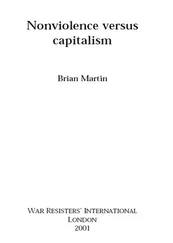Anders Boserup and Andrew Mack, in their pioneering book War Without Weapons, apply Clausewitzian strategic theory to social defence. The centre of gravity is the opponent’s central source of strength, which should be the main target for destruction. The centre of gravity of the defence is determined by the mode of defence, which is the basis for Clausewitz’s idea of the superiority of the defence over the offence. Boserup and Mack conclude that for a social defence system, the centre of gravity is the unity of the resistance: “It is against this point that the whole thrust of the attack must be directed and to its preservation that all efforts of the defence must tend.” [11] . Anders Boserup and Andrew Mack, War Without Weapons: Non-violence in National Defence (London: Frances Pinter, 1974), pp. 148-182, quote at p. 163.
If the defence is able to absorb the attack, then its next task is to mount a counterattack against the centre of gravity of the opponent. Boserup and Mack say that in the case of military attack against a social defence system, the centre of gravity of the offence depends on the mode of attack and that, generally speaking, it will be those things that allow the offence (for example, repression of the nonviolent defenders) to continue.
Other social defence theorists have built on Boserup and Mack’s analysis but differed about the precise nature of the centre of gravity. Gene Keyes, who studied the Danish resistance to the Nazis, concludes that the centre of gravity for a social defence system is the morale of the resistance. [12] . Gene Keyes, “Strategic non-violent defense: the construct of an option,” Journal of Strategic Studies , Vol. 4, 1981, pp. 125-151, at p. 133.
Robert Burrowes, in a far-reaching Gandhian approach to social defence strategy, argues that the strategic aim of the defence is to “consolidate the power and will of the defending population to resist the aggression” and the strategic aim of the counteroffensive is to “ alter the will of the opponent elite to conduct the aggression, and to undermine their power to do so.” [13] . Robert J. Burrowes, The Strategy of Nonviolent Defense: A Gandhian Approach (Albany, NY: State University of New York Press, 1996), p. 209.
In Burrowes’ model, the centre of gravity is the sum total of social resources that support the strategy; more specifically, it is the power of a party to a conflict to conduct the struggle and its will to do so. Both Keyes and Burrowes say that the centre of gravity for the offence is the same as for the defence, namely morale for Keyes and power/will for Burrowes.
Although Boserup and Mack, Keyes and Burrowes differ concerning the location of the centre of gravity of a social defence system, they agree that it lies primarily in the social and psychological facets of the resistance, namely either unity, morale or will. It certainly is not technology (weapons). However, technology can be used to bolster unity, morale and will.
As for factors classified as physical infrastructure in the list of key factors in a social defence system, communication technology is probably the most important because of its close link to psychological and organisational factors. Only seldom is survival of the population threatened in a nonviolent resistance, [14] . One case is the Palestinian intifada, though the resistance is better described as unarmed than nonviolent.
and industry only occasionally plays an important role. The capacity to understand, resist, and dismantle weapons of the aggressor is a topic seldom discussed in the nonviolence literature.
This list of key factors provides a preliminary way to assess the importance of scientific fields to nonviolent struggle. For example, consider biology: it can offer some help in the task of survival, for example via understanding of ecology, such as knowledge of species not requiring pesticides or fertilisers (which might be unavailable in event of a blockade) or fruit-bearing species. Biologists could also provide some insight into the capability of biological weapons and how to counter them.
Proceeding in this fashion for all the key factors leads to the following list.
Relevance of Science and Engineering to Key Elements in a Social Defence System
biology : survival; anti-biological weapons
chemistry : anti-chemical weapons
earth sciences : survival
medicine : survival
agricultural science : survival
physics/mathematics : communication
computing/electrical engineering : communication
engineering : survival; industry, etc.; communication; anti-conventional weapons
psychology : morale, etc.
languages : communication
economics : industry, etc.
sociology, politics, philosophy, history, education : knowledge, etc.; coordination, etc.
Although this list is not definitive, it gives a good indication of the relevance of various fields to nonviolent struggle. It is apparent that a number of fields of science and engineering can contribute to survival (earth sciences, medicine, agricultural science, most branches of engineering) and a number of them can contribute to communication (computer science, electrical engineering, mathematics). But aside from a few other areas (chemistry can contribute to anti-chemical warfare; engineering has a crucial role in designing industry for a social defence system), the bulk of science and engineering has little to offer to nonviolent struggle.
This conclusion needs an immediate qualification. Aside from contributions to survival and communication, the bulk of present-day science and engineering seems to offer little to nonviolent struggle. It is quite possible that these fields could be more relevant if they were redirected — for example through a change in funding patterns — from military to nonviolent goals. In terms of present systems of knowledge, skills and hardware, the social sciences have a much more important role to play in supporting social defence than do the natural sciences and engineering.
In summary, a comparison of research priorities for military and nonviolent ends shows some dramatic differences at a number of levels. Research into improving nonviolent struggle would lead to a much greater emphasis on social science than does military-related research. Within individual disciplines, a priority on nonviolent struggle would mean greater attention to particular fields, such as telecommunications. Finally, within particular fields, such as telecommunications, a nonviolence-oriented research agenda would lead to emphasis on different puzzles.
A science and technology policy based on promoting social defence would be dramatically different from one based on promoting military strength. The following changes would be among the most significant.
(1) There would be much greater emphasis given to social sciences compared to natural sciences and engineering. The implication is that the present situation in which natural science and engineering receive the bulk of research monies is, to some degree, a product of military priorities operating in the past century, and that quite a different balance between the `soft’ and `hard’ sciences might eventuate if social defence received the same investments and priority now given to the military.
Complaints by scholars in the humanities and social sciences that they are shortchanged in the struggle for research money typically make appeals to intellectual worthiness or the importance of culture. The analysis here provides quite a different argument: that social science — or, more precisely, particular branches of social science — are central to the development of the capacity of a society to defend itself using nonviolent methods. (It should be noted that present-day social science has been shaped by military priorities and that a social science shaped by social defence priorities might look quite different.)
Читать дальше












